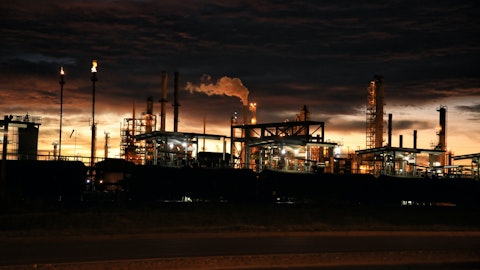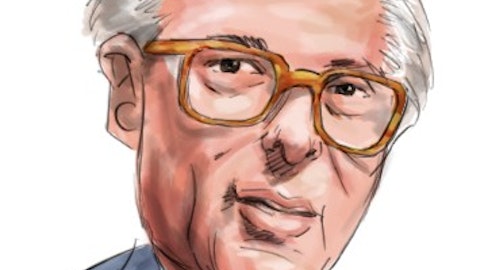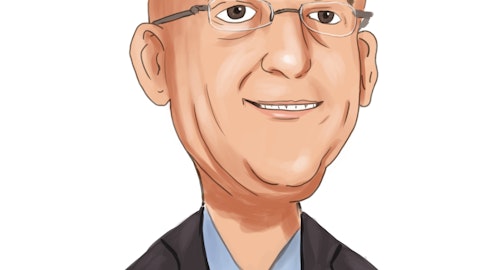Ultrapar Participações S.A. (NYSE:UGP) Q3 2023 Earnings Call Transcript November 10, 2023
Operator: Good morning, ladies and gentlemen, and thank you for waiting. At this time, we would like to welcome everyone to Ultrapar’s Quarter 3 2023 Earnings Conference Call. There is also a simultaneous webcast that may be accessed on Ultrapar’s website at ri.ultra.com.br and MZiQ platform. The presentation will be conducted by Mr. Rodrigo Pizzinatto, Ultrapar’s Chief Financial Officer and Investor Relations Officer. And then for Q&A session, we’ll have also have the presence of Mr. Marcos Lutz, Ultrapar’s CEO and the CEOs of the respective businesses, Mr. Tabajara Bertelli, Mr. Décio Amaral and Leonardo Linden. We would like to inform you that this event is being recorded and all participants will be in listen-only mode during the company’s presentation.
After Ultrapar’s remarks, we will open the floor for questions and at that time, further instructions will be given. [Operator Instructions] We remind you that questions, which will be answered during the Q&A session, may be posted in advance in the webcast. And a replay of this call will also be available for seven days. Before proceeding, let me mention that forward-looking statements made during this conference call under the safe harbor of the Securities Litigation Reform Act of 1996 are based on the beliefs and assumptions of Ultrapar management and on information currently available to the company. They forward-looking statements are no guarantee of performance. They involve risks, uncertainties and assumptions because they relate to future events, and therefore depend on circumstances that may or may not occur in the future.

An executive in a suit and tie reviewing a financial plan in a boardroom.
Investors should understand that general economic conditions, industry related conditions and other operating factors could also affect the future results of Ultrapar and could lead to results that differ materially from those expressed in such forward-looking statements. Now, I’d like to turn the conference over to Mr. Rodrigo Pizzinatto. Mr. Pizzinatto, you may proceed.
Rodrigo Pizzinatto: Good morning everyone. It is a pleasure to be here once more to talk about Ultrapar’s results. And starting on slide number two, I remind you that both the earnings release in this presentation consider Ultrapar’s data from continuing operations in 2023. As for 2022, the company’s data is presented in the pro forma view, considering the sum of continuing and discontinued operations, as disclosed throughout last year unless otherwise stated. Moving now to slide number three with Ultrapar’s consolidated results. As you can see in the chart in the upper left side, our recurring EBITDA from continuing operations totaled BRL1992 million in the third quarter of 2023, 124% higher year-over-year. This increase is due to the higher EBITDA at our businesses, especially Ipiranga results that I will go through in detail in the next slides.
Ultrapar’s net income was BRL891 million in the third quarter compared to BRL83 million in the third quarter of ’22, mainly on the back of the higher EBITDA from continuing operations. Investments from continuing operations totaled BRL380 million in this third quarter, 27% lower than that of the third quarter of ’22, due to lower investments at Ipiranga partially offset by higher investments at Ultracargo. We had in the third quarter an operating cash generation of BRL1901 million, BRL609 million above that of the third quarter of ’22. This increase is a result of the higher EBITDA, partially offset by the reduction in draft discount balance and the investment in working capital in the third quarter of ’23 and arising from the increase in fuel prices.
I remind you that in the third quarter of ’22, on the other hand, there was a release of working capital as a consequence of the reduction in fuel prices in that period. If we exclude the reduction of BRL294 million in the draft discount balance, the operating cash generation in this third quarter was BRL2195 million. Moving now to slide four to talk about our liability management. We ended the third quarter with a net debt of BRL7.1 billion, a reduction of BRL924 million compared to June ’23. This decrease resulted from greater operating cash generation, partially offset by the payment of dividends and the reduction of BRL 294 million in the direct discount balance this quarter. In addition to this effect during the third quarter, we received the second installment from the sale of Extrafarma in the amount of BRL 198 million and we disbursed BRL 210 million for the acquisition of Opla.
Our leverage went from 2.1x in June 2023 to 1.4x in September 2023, the lowest level of the last 10 years. On the back of the higher LTM EBITDA from continuing operations with cash generation and consequently the reduction in net debt that I’ve just mentioned. I’d like to point out that the numbers of net debt still do not include pending receivables of BRL 932 million related to the sales of Oxiteno and Extrafarma. We’ve included at the bottom of this slide, a table with the total amount of draft discount and vendor lines as well as pending receivables from the sales of Oxiteno and Extrafarma all lines highlighted in our balance sheet. The net debt of September 2023 adding the draft discount vendor and divestment receivables would be BRL 7.7 billion, which is BRL 1746 million lower than the balance of September 2022 one year ago.
Moving on to Slide number 5 to talk about another excellent quarter of Ultragaz. The volume of LPG sold in this third quarter was 1% higher year-over-year, due to a 4% increase in the bulk segment on the back of higher sales to industries. The bottled segment in its turn remained flat. Ultragaz SG&A in this third quarter was 15% higher than that of the third quarter of 2022, due to two manufacturers expenses with freight due to higher sales volume and higher expenses with personnel, mainly collected by gaining agreement in variable compensation in line with the progression of results and a larger headcount due to the acquisitions of Stella and NEOgas. Ultragaz EBITDA totaled BRL 453 million, 36% higher year-over-year. This growth is mainly explained by efficiency and productivity initiatives implemented in the last quarters, by better sales mix and by inflation pass-through despite higher expenses.
For the fourth quarter, we expect a profitability measured in EBITDA per ton similar to that of the third quarter despite seasonally lower volumes. Moving now to Slide 6 to talk about another great quarter of Ultracargo. The company’s average installed capacity was 10,59,000 cubic meters in the third quarter of 2023 and a 11% growth year-over-year. This increase results from three capacity additions carried out in recent months 90,000 cubic meters coming from the acquisition of the 50% stake in Opla as of July 12,000 cubic meters from the acquisition of the Rondonopolis base from Ipiranga in September and 10,000 cubic meters relating to the expansion of the Vila do Conde terminal. These capacity additions had no material impact in this quarter’s results and should begin to gradually contribute to the upcoming months as operations ramp up.
The cubic meters sold increased by 26% mainly due to higher handling of use in Itaqui in Santos and in Suape and the start up of operations in Opla. Truck cargo’s net revenues were BRL 264 million in this third quarter, 18% higher year-over-year as a result of spot sales, higher cubic meters sold and higher tariffs. Combined cost and expenses were 8% higher than those of the third quarter of 2022, as a result of higher personnel expenses mainly collective bargaining agreement in variable compensation in line with the progression of results. We also had higher expenses with advisory and consulting services linked to expansion projects. Truck cargo’s EBITDA totaled BRL 173 million in the quarter, a growth of 27% year-over-year due to higher capacity occupancy with profitability gains, spot sales, higher tariffs and productivity and efficiency gains despite higher expenses.
EBITDA margin was 65% in this quarter, five percentage points above that of the third quarter of 2022. And for the current quarter, we expect Ultracargo to continue its good operating performance, but with fewer spot sales marginally reducing its results. And to conclude this presentation moving on to slide 7 let’s talk about Ipiranga’s result. Volumes sold in the quarter decreased 2% year-over-year with a 3% reduction in the Otto cycle and a 1% reduction in diesel mainly due to the strategy of lower sales to the spot market during this period. We ended the third quarter with a network of 5,816 service stations, 565 stations less than that of June 2023. In September, we concluded the process of managing the legacy of service stations started in 2022.
A total of 70 new service stations were added to the network with an average volume contribution of 288 cubic meters per month. On the other hand, 535 service stations were closed with an average volume contribution of 57 cubic meters per month. The greater number of stations closed this quarter relates to the decision to also close service stations with commercial practices not aligned with business principles and in this agreement with contractual obligations. This increased level of closure of stations did not have a relevant impact on Ipiranga’s market share or results. In addition, we ended the quarter with 1,542 Am/Pm stores with same-store sales growth of 9% year-over-year. Ipiranga’s SG&A increased 27% in the quarter due to four main factors: higher provisions for contingencies, higher provision for doubtful accounts, higher marketing expenses and higher personnel expenses mainly collective bargaining agreement in variable compensation in line with the progression of results.
The other operating results line totaled negative BRL178 million in the quarter in line with the third quarter of 2022. The disposal of assets line totaled BRL68 million mainly due to the capital gain related to the sale of the Rondonopolis base to Ultracargo in the amount of BRL59 million and the sale of three real estate assets. Ipiranga’s EBITDA totaled BRL1513 million in the quarter, 184% higher than that of the third quarter of 2022. Recurring EBITDA was BRL1,445 million in the quarter 199% higher year-over-year. The higher EBITDA mainly reflects two factors: first, margins benefited from the inventory gains caused by the increase in fuel costs throughout the quarter. I remind you that in the third quarter of 2022, we had reductions in fuel costs and inventory loss.
The second factor was the normalization of the commercial environment in the third quarter of 23% due to a more regular product supply in the market which affected the second quarter results. These two factors were partially offset by higher expenses. As you may have noted, the fuel distribution sector has had more volatile results in recent quarters. Therefore, we also highlighted on the slide the EBITDA per cubic meter of the last 12 months helping to provide a better perspective of the results over time. In addition, to the normalization of product supply the third quarter result benefited from inventory gains. For the fourth quarter considering the current scenario of product supply and no significant impact of inventories, we expect a profitability measured in EBITDA per cubic meter above that of the last 12 months and continued recovery of the return levels of the industry.
With that, I now conclude my presentation. I appreciate your interest and attention. And let’s now move on to the Q&A session in which we are available to answer your questions. Thank you.
See also 25 Best US Cities Where You Can Retire on $2,000 a Month and 13 Best DRIP Stocks To Own.
Q&A Session
Follow Ultrapar Participacoes S A (NYSE:UGP)
Follow Ultrapar Participacoes S A (NYSE:UGP)
Operator: Ladies and gentlemen, we will now open the floor for questions. [Operator Instructions] The first question comes from Monique Greco, Itau BBA.
Monique Greco: Hello, everyone. Good morning. Can you hear me?
Marcos Lutz: Yes. Good morning, Monique.
Monique Greco: Good morning. Thank you for your presentation. Congratulations on your strong results. I have two questions on my side. Let me start from the end of your presentation, Pizzinatto. You talked about the dynamics expected in terms of margin for quarter four in Ipiranga. Can you please share with us a little bit more about what you are feeling in terms of the competitive dynamics in quarter four? We saw that in the first half of the year this competitive dynamics was very late with a products imported from Russia. So, can you please share with us what you see for the dynamics — the diesel dynamics in quarter four? And also we have been talking a lot about diesel and the Otto cycle dropped in the background. So, we also like to hear from you what the dynamics look like for the Otto cycle.
And — my question to Lutz is that in Ultra Day, you talked a lot about the opportunities [indiscernible] with a strong focus on agri business and also energy transition. So, can you please talk more about this [indiscernible] opportunities in this sector? What are the main criteria that you consider when you’re looking at these opportunities? Thank you
Leonardo Linden: Hello Monique. This is Linden. On your first question was about competitive dynamics. Of course this is a never competitive market. And in quarter four, we are seeing a more balanced situation in terms of supply and demand, which balances out the market. But we have to look at this market as a movie and not a snapshot. What we saw in quarter three was indeed a favorable scenario for our business, but we cannot forget that we were coming from a quarter one, which was very poor in terms of — we had some major inventory losses with a high supply of diesel as you said yourself. And this scenario started to change in quarter three and then we had some inventory gains and better market conditions. And in quarter four, I’d say this is more balanced.
But it is a transition quarter because we are also starting to see some parity opening up, we start to see a higher appetite for imports. So, I think we will have a transitional quarter in quarter four. But as you heard in Rodrigo’s explanation, we are looking at quarter four with — potentially with higher margins than what we saw in the past 12 months. And just an additional comment Monique in the first half we had an excess of products in the market. And retail fuel is no different from our industry so you have excess product that will negatively impact your margins which is what we and what we had in quarter three and that should remain in quarter four is this return to normal levels normal stock levels in the industry and that allows our margin to return to the levels expected.
So, now I’d like to hand the conference over to Marcos.
Marcos Lutz: Hello Monique. Good morning. So, let’s start by the criteria which I think is the most important point in your question. We will have to have huge discipline looking at the risk/return ratio of our projects. As we said, we want to be more exposed business. We want to grow more in these regions in our three areas of business; Ultracargo, Ultragaz, and Ipiranga are making all the efforts to expand their operations in these markets. And we are considering multiple projects and companies that have a higher exposure to these markets. And the main criterion here is the return on investment, of course, combined with the risks of this investment. So, these are more mature projects that give us slightly lower return but have also lower risk, are very attractive, and less mature projects have higher risk and that has to be justified.
And also about risk/return, it is important to note that even with the current return levels, the risk/return ratio of field distribution project in Brazil is not yet appropriate. We have a volatility level that we think is here to stay in this segment. And this would warrant a high — requirement for a higher return from these projects today. We see for example, that the price in Brazil is higher than the international price. So this increases the entrance of products, so we should have an inventory loss because we should see a price reduction in Brazil shortly in the future, because it doesn’t make sense to have a price which is not higher than the international price. So, we will see this volatility taking place. It’s what I said about seeing it as a movie versus a snapshot.
We need to bring more focus on in the past 12 months and not just the past quarter to evaluate whether we are going in the right direction or not.
Monique Greco: Perfect. Thank you.
Operator: The next question comes from Leonardo Marcondes, Bank of America.
Leonardo Marcondes: Good morning. Thank you for taking my question. I have two questions about Ipiranga. My first question is about the service stations. Can you please recap what are the effects that we can expect in Ipiranga after you finish this project with Ultragaz? And also what can you expect from the company in terms of the future or your brand strategy for the future. And also I have a question about Ipiranga’s business — Ipiranga’s margins. You already mentioned what you expect for quarter four. But looking at the mid to long-term, I think your market having a recurring margin of about BRL100 or BRL110 per cubic meter from you. In your mind, is this level of margin make sense or do you think you can have a stronger recurring margin for Ipiranga moving forward?
And still within this context considering the four pillars of the turnaround process of the company, is there still room for improvement in your opinion? And if yes, this improvement will come for each pillar — for which pillars? You remember that there was — I remember you mentioned that there were some improvements to be made in your network and logistics. So can you give us more color about that?
Rodrigo Pizzinatto: Hello Leonardo. Good morning. Thank you for your question. Well, about the close down of service station, I’d say that the effect will be a healthy effect both from the Ipiranga standpoint and also the reseller standpoint. This was a clearance of legacy service stations that we absolutely had to do, and as you said, we are coming to the end of this process and what we still expect to have in the future is a natural clearance of our network and service stations, which takes place naturally. But the bulk of this process is already finished. And you start to see the effect, for example, when you start seeing productivity gains or increased productivity of each Ipiranga service station. For the brand strategy, we will continue with the same strategy that we have been using so far.
We are making investments raising the bar of quality because of the reasons we mentioned before, because we won points of sale that have the highest potential. We are looking at our business prioritizing the highest returns on service stations, because this brings us a healthier relationship. And we will keep investing as we have been investing in the past years, as I said, with now a slightly higher level of quality. We are always raising the bar. Now as for the margin, we talked about this during Monique’s question, but you asked us if this makes sense. One thing is what we expect. And another thing is what we should have according to the compensation we will have expected for the business. For the next quarter or this quarter that is starting, now we’re expecting a margin higher than what we saw in the past 12 months.
But what we should have in this business is something that could provide us with a return of about 20%, which is what we are pursuing. So as an industry, I think we still have room to improve in terms of profitability and that’s what we have been working for.
Leonardo Marcondes: Just one follow-up question about service stations, I remember that it was the point of depreciation. And now with a healthier network, I imagine that there will be a positive impact on the receivables of Ipiranga overall. So can you please talk about this just to recap?
Rodrigo Pizzinatto: Hello Leonardo. This is Rodrigo. Yes, we should see a benefit in the reduction of amortization and depreciation for Ipiranga, but remember that we have other investments to make, so it’s the dynamics in our depreciation. But this standalone effect finished now in the month of September, so we should see this benefit of reduction in our depreciation and amortization. And I didn’t understand your question about the impact on non-IFRS.




